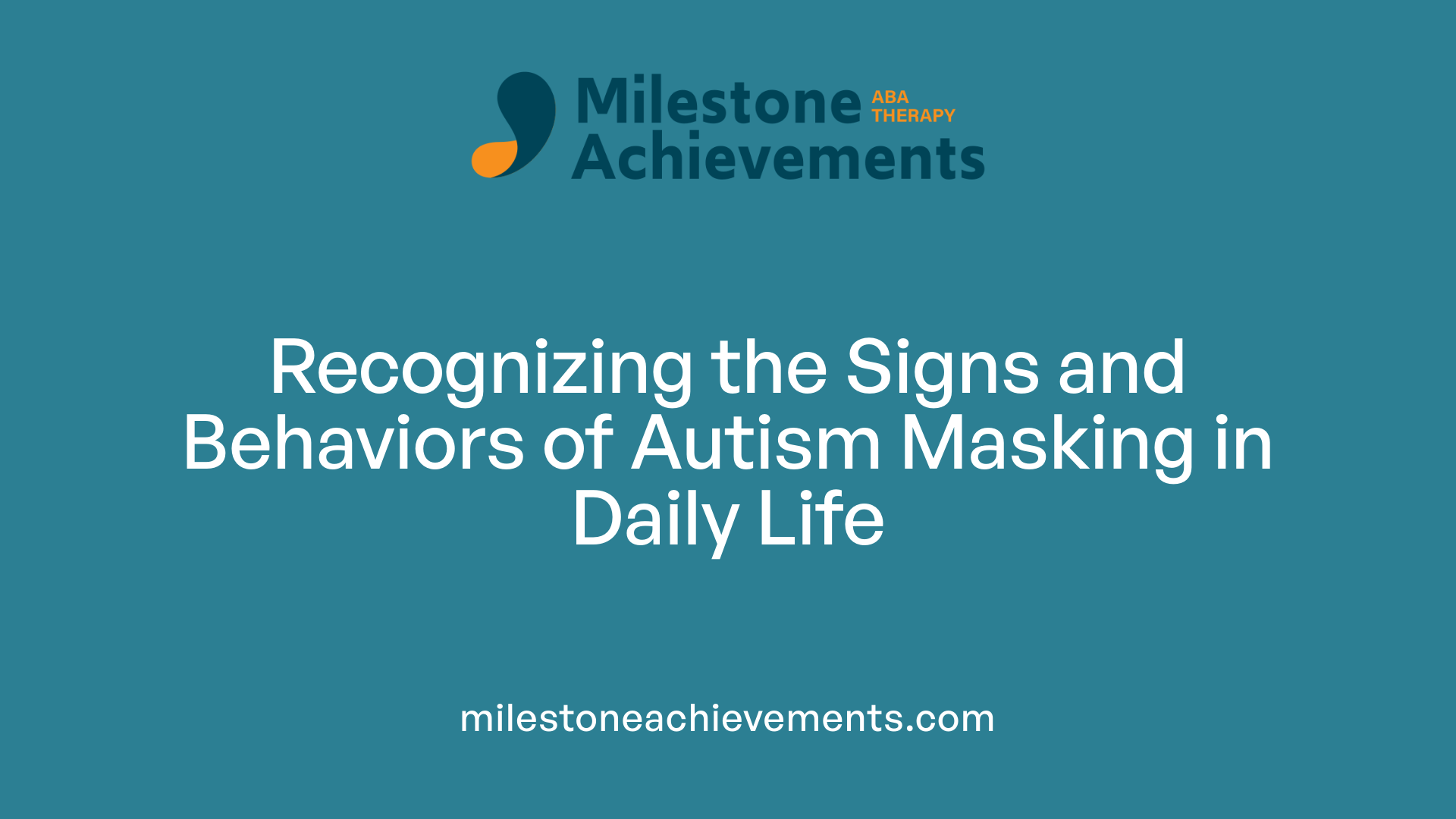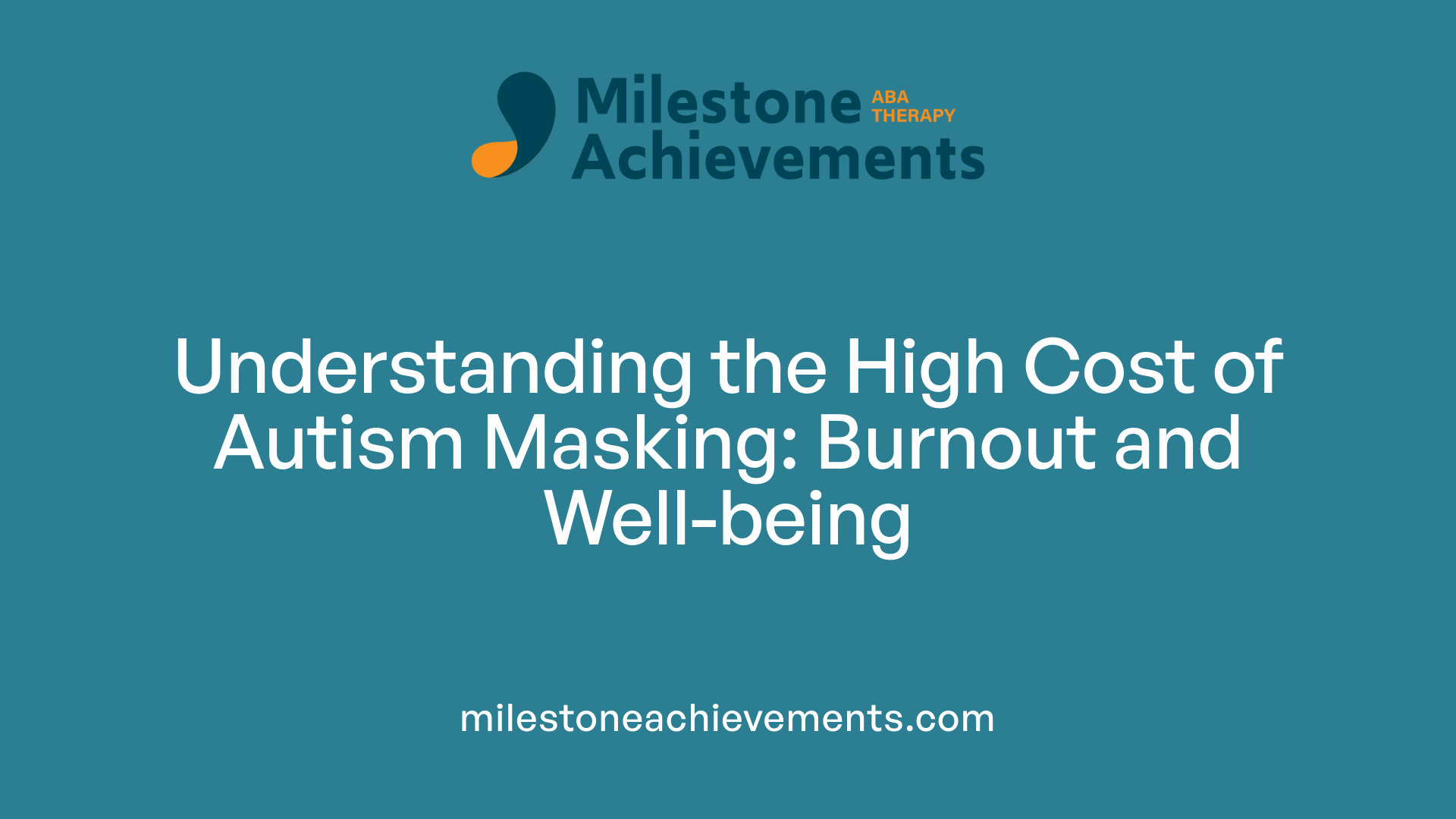Understanding Autism Masking Behavior
Unmasking the Hidden Struggles of Autistic Individuals

Understanding the Complex World of Autism Masking
Autism masking, also known as camouflaging, is a phenomenon where individuals with autism spectrum disorder (ASD) consciously or unconsciously modify their outward behaviors to conform to neurotypical social expectations. This intricate adaptation is often driven by societal pressures, environmental factors, and personal safety concerns. While masking can facilitate social acceptance temporarily, it carries profound implications for mental health and authentic self-expression. This article explores the concept, development, signs, effects, and support strategies related to autism masking, emphasizing the need for societal understanding and systemic change.
What is Autism Masking and How Can It Be Explained?
What is autism masking and how can it be explained?
Autism masking, also known as camouflaging, refers to the conscious or unconscious effort of autistic individuals to hide or suppress traits associated with autism. This behavior is often motivated by a desire to fit into societal norms, avoid discrimination, or prevent bullying. People may mask by mimicking neurotypical behaviors such as maintaining eye contact, rehearsing conversations, or suppressing stimming—repetitive movements or sounds.
This process involves a range of behaviors, including developing social scripts, mimicking facial expressions, hiding personal interests, or engaging in rehearsed responses during interactions. High-masking individuals, especially females or those who have experienced social rejection, are often highly observant and analytical of social cues, enabling them to blend seamlessly into their environments.
While masking can sometimes help with social acceptance or professional success, it comes with significant emotional and mental costs. The effort required to constantly adapt and hide one's natural behaviors can lead to exhaustion, stress, and feelings of disconnection from one's true self. Over time, this can increase the risk of mental health issues such as depression, anxiety, and burnout.
Understanding why masking occurs is crucial. Many individuals mask to feel safe, succeed in social or work settings, attract romantic partners, or avoid negative reactions. It often starts at a young age, especially in response to societal pressures and systemic ableism. Despite its protective short-term effects, persistent masking can hinder genuine self-expression and delay autism diagnosis, particularly in women and adults.
Supporting autistic individuals involves creating environments that value authenticity, reduce stigma, and offer acceptance. This approach can lessen the reliance on masking behaviors, allowing individuals to express themselves freely and maintain better mental health.
Development and Age of Onset of Masking Behaviors
When masking starts
Autistic masking can begin surprisingly early in life, sometimes as early as ages 2 to 5. During these formative years, children may start to behave differently in social situations to avoid negative reactions or punishment. For example, they might pretend to enjoy certain activities or suppress natural behaviors like stimming to fit in with peers.
This early onset is often subtle and hard to differentiate from typical childhood development. Children might not be aware they are masking; rather, they learn over time that certain reactions or behaviors are either accepted or rejected by their environment.
Progression through childhood and adolescence
As children grow, social expectations become more complex and pressure to conform increases. Between ages 5 and 12, many children with autism start to develop more deliberate masking strategies. They may rehearse social scripts, imitate friends or family members, and consciously suppress behaviors like repetitive movements or intense interests.
During adolescence, masking often intensifies. Teenagers, especially girls and young women, may become highly skilled at camouflaging their traits to avoid bullying, social rejection, or to succeed in school and social settings. This period is critical, as sustained masking can be exhausting and sometimes lead to mental health issues like anxiety or depression.
Understanding the typical age of onset and how masking evolves helps caregivers and professionals provide better support. Recognizing these behaviors early can also lead to more accurate diagnoses and interventions, ultimately reducing the risks associated with prolonged masking.
Common Examples of Autism Masking Behaviors
What are some common examples of autism masking behavior?
Autistic individuals often engage in various behaviors to hide or suppress their natural traits in social settings. These masking behaviors are efforts to appear more neurotypical and avoid negative judgments or stigma.
Some typical examples include forcing eye contact, even if uncomfortable, to meet social expectations. They might imitate or copy speech patterns, gestures, or facial expressions to seem more similar to others.
Suppressing natural stimming behaviors, such as hand-flapping or rocking, is another common technique. Instead, individuals may hide these actions or replace them with socially acceptable gestures.
Others develop and rehearse social scripts or responses to prepare for conversations. They might script out typical dialogues or memorize responses to navigate social interactions more smoothly.
Hiding expressive emotions, especially if they are intense or visible, helps avoid misunderstandings or negative reactions. Some also conceal their special interests or hobbies that might seem unusual.
Managing sensory responses by enduring overstimulating environments or hiding sensitivities is also a form of masking. For instance, suppressing sounds or avoiding reactions to sensory overload.
All these behaviors require significant mental effort and can lead to exhaustion, emotional stress, and identity conflict over time. Recognizing these signs is important to better support autistic individuals and foster environments where they feel safe being their authentic selves.
Signs and Characteristics of Autism Masking

Observable signs in daily life
Autism masking manifests in various behaviors that autistic individuals may display in everyday situations. These signs often stem from conscious or unconscious efforts to hide or minimize natural traits to appear more neurotypical.
One prominent sign is mimicking social behaviors, such as copying body language, facial expressions, or speech patterns observed in others. Individuals might rehearse or script conversations to feel prepared, which can be noticed through rehearsed responses or exaggerated politeness.
Managing eye contact is another common characteristic. Many autistic people either avoid eye contact altogether or maintain it for extended periods, sometimes uncomfortable for them but done to meet social expectations.
Suppressing stimming behaviors—repetitive movements or sounds that help regulate sensory input—is frequently observed. For example, a person might hide hand-flapping, rocking, or humming, or replace these with subtler actions.
Hiding special interests by steering conversations away from topics they are passionate about is also part of masking. This is often accompanied by developing rehearsed scripts, where responses are practiced to navigate social interactions smoothly.
In terms of body language and facial expressions, individuals might deliberately display socially accepted gestures, suppress signs of stress or discomfort, and force smiles during interactions.
Masking often requires considerable mental effort, leading to exhaustion and heightened stress. It can also contribute to feelings of anxiety, depression, and a sense of disconnection from one’s true self.
This behavior is notably more prevalent among women and girls, who may face heightened social pressures to conform. While masking can help them gain acceptance and access opportunities, it can also have serious long-term effects on mental health.
Recognizing these signs in daily life is crucial for understanding and supporting autistic individuals. Creating safe spaces where natural behaviors are accepted encourages authenticity, reduces the need for masking, and promotes overall well-being.
The Effects and Consequences of Masking on Mental and Physical Health

What is autism masking burnout and what causes it?
Autism masking burnout is a state of profound mental, physical, and emotional exhaustion caused by the persistent effort to hide autistic traits and conform to societal norms. This type of burnout arises from the continuous stress and high energy demands of masking behaviors, such as suppressing stimming, mimicking expected social behaviors, or managing sensory overloads.
Many autistic individuals start masking as a way to avoid social rejection, judgment, or discrimination. Over time, this sustained effort leads to overwhelming fatigue, a decline in emotional resilience, and sometimes a loss of skills or identity. Common signs of burnout include chronic tiredness, heightened sensory sensitivities, and increased susceptibility to mental health issues like depression.
Addressing masking burnout involves creating supportive environments that value authenticity. Allowing breaks from mask-wearing, practicing self-care, and fostering acceptance help reduce the toll of masking. Recognizing when an individual is experiencing burnout is crucial to providing the right support and preventing long-term harm.
How does masking affect overall well-being?
Masking significantly impacts the overall health and well-being of autistic individuals. Since masking demands a lot of emotional and cognitive energy, it often leads to exhaustion and burnout.
One of the most profound effects is a feeling of disconnection from oneself. Regularly suppressing core autistic behaviors, such as stimming or expressing interests, can cause individuals to feel like they are living inauthentically. This dissonance between their true self and their outward persona may foster feelings of alienation and low self-esteem.
Mentally, constant masking increases the risk of anxiety and depression. The effort to hide neurodiverse traits can foster a sense of shame or self-criticism, compounding emotional distress. Physically, the stress associated with masking can lead to health problems, such as fatigue, headaches, or sleep disturbances.
Societal pressures and stigma play a major role in reinforcing masking. The fear of being misunderstood or mistreated compels many to hide their true selves, further fueling emotional disconnection. Encouraging acceptance and creating environments where authenticity is supported can lead to better mental health and a reduction in exhaustion, helping autistic individuals feel more comfortable and valued.
Supporting and Unmasking: Strategies for Change

What are strategies for supporting autistic individuals who mask their behavior?
Supporting autistic individuals who mask their behavior requires a compassionate and understanding approach. Creating accepting environments is essential, where neurodiversity is celebrated and natural behaviors such as stimming are normalized. Encouraging self-awareness and self-compassion can help individuals recognize their masking patterns without shame.
Mental health practices like mindfulness and cognitive-behavioral therapy (CBT) can provide tools for managing stress related to masking. Offering access to support groups and tailored therapies helps individuals explore their authentic selves safely. Importantly, accommodations—such as sensory-friendly spaces and flexible social expectations—reduce the pressure to hide autistic traits.
Educating friends, family, and colleagues about autism and masking fosters greater empathy and reduces stigma. Creating a culture that values authenticity and understands the reasons behind masking ensures that autistic individuals feel supported rather than judged. Ultimately, supporting unmasking is about building trust and encouraging personal journeys toward genuine self-expression.
How can society foster environments that support unmasking and authenticity?
Building inclusive spaces hinges on recognizing neurodiversity as a valuable aspect of human variation. Schools and workplaces can implement accommodations that respect sensory sensitivities and support social interactions without pressure to conform. Awareness campaigns can dispel myths about autism, emphasizing acceptance over correction.
Training staff and community members to understand masking behaviors and their underlying reasons cultivates empathy. Normalizing natural autistic behaviors, such as stimming or expressing intense interests, reduces stigma and encourages authenticity.
Creating safe spaces where autistic individuals can express themselves freely is crucial. Community support networks and peer groups offer environments for shared understanding and acceptance. Society’s efforts to foster respect, understanding, and flexibility help reduce the societal pressures that drive masking, ultimately leading to healthier, more genuine connections for autistic people.
The Importance of Societal and Systemic Change

Reducing stigma
Addressing the societal stigma surrounding autism is crucial in decreasing the pressure to mask. Stigma often results from misconceptions and stereotypes about what it means to be autistic, leading many individuals to hide their traits to avoid judgment or discrimination. Education campaigns, media representation, and community engagement can help foster understanding and acceptance.
Creating spaces that are welcoming and respectful of neurodiversity encourages autistic people to express themselves authentically. Schools, workplaces, and social venues can implement policies promoting inclusion, such as sensory-friendly environments and awareness training.
Creating inclusive spaces
Inclusion involves designing environments where autistic individuals feel safe and valued without the need to hide their behaviors. This includes physical adaptations, such as quiet zones and flexible routines, as well as social acceptance of diverse interaction styles and sensory preferences.
Supporting inclusive spaces also means raising awareness, normalizing autistic expressions like stimming, and reducing societal expectations of conformity. When communities recognize neurodiversity as a natural variation, it helps diminish the compulsion to mask and nurtures authentic connections.
How systemic changes promote understanding and acceptance of autistic masking
Transforming social environments to embrace neurodiversity involves comprehensive policy and attitude shifts. Systemic change includes:
| Strategy | Example | Purpose |
|---|---|---|
| Policy reform | Laws mandating accommodations for autistic workers | Ensure equitable opportunities |
| Education initiatives | Incorporating autism awareness into school curricula | Build understanding from a young age |
| Media representation | Featuring autistic characters in TV and film | Reduce stereotypes |
| Community programs | Sensory-friendly events | Promote inclusive participation |
| Leadership representation | Autistic individuals in decision-making roles | Elevate authentic voices |
These strategies help shift societal perceptions from viewing autism as a deficit to recognizing it as a natural and valuable human variation. Such systemic reforms reduce stigma, alleviate pressure to mask, and support people in living more authentic lives.
Supporting words and tools
Advocacy campaigns and organizations emphasize the importance of creating environments where masking is not necessary for acceptance. Resources like the 'Camouflaging Autistic Traits Questionnaire (CAT-Q)' enable individuals to understand their behaviors and foster self-compassion.
In summary, systemic change is foundational to fostering understanding, reducing stigma, and creating society-wide acceptance of neurodiversity. By implementing inclusive policies, educating the public, and promoting authentic representation, we can help reduce the need for masking and support autistic people in living genuine, fulfilling lives.
Research Insights and the Future of Autism Masking Understanding

What scientific research exists on autism masking, and what insights does it provide?
Research into autism masking, often called camouflaging, sheds light on how autistic individuals consciously or unconsciously alter or hide their natural traits. These behaviors are performed to blend in with neurotypical social expectations, avoid stigma, and navigate social environments more comfortably.
Studies have documented various masking behaviors. Examples include mimicking facial expressions, controlling or suppressing stimming, scripting conversations, and studying social cues to imitate typical interactions. This research typically traces the start of masking behaviors back to childhood, especially when young individuals face social rejection, bullying, or harsh discipline for their natural behaviors.
A critical insight from scientific studies is that masking requires substantial cognitive effort and emotional energy. While it can temporarily improve social acceptance, it often leads to negative outcomes like emotional exhaustion, burnout, and a loss of authentic self-identity. Importantly, masking is also linked to delayed diagnoses, particularly in females, because their outward behaviors may appear more neurotypical, masking underlying autistic traits.
Furthermore, research points out that prolonged masking increases risks for mental health issues, including anxiety, depression, and suicidal ideation. The Camouflaging Autistic Traits Questionnaire (CAT-Q), developed in 2019, helps measure masking behaviors by assessing how individuals compensate, mask, and assimilate socially. This tool offers valuable insight into internal camouflage strategies and has helped quantify the extent of masking among autistic adults.
Overall, these studies highlight the necessity to recognize masking behaviors to foster better support, improve diagnostic accuracy, and reduce long-term mental health risks. As awareness grows, so does the importance of creating supportive environments where autistic traits can be exhibited naturally without fear or suppression.
Moving Towards Acceptance and Support
Understanding autism masking behavior is essential for fostering empathy, reducing stigma, and creating environments that permit genuine self-expression. Recognizing the signs, causes, and impacts of masking can lead to better diagnostic practices, targeted mental health support, and societal reforms that celebrate neurodiversity. Empowering autistic individuals to unmask safely and authentically requires systemic change, inclusive spaces, and community awareness. As society progresses in its understanding, it becomes possible to diminish the necessity of masking altogether, allowing individuals to live more truthful, fulfilled lives.
References
- Autism Masking Is Common. Here's How To Recognize And Offer ...
- Understanding Autism Masking and Its Consequences - Healthline
- What is Masking in Autism? Autistic Masking Explained
- Understanding Masking: A Neurodiversity-Affirming Perspective
- Autistic masking - Wikipedia
- The Hidden Complexity of Autism: Understanding Masking - Cortica
- Camouflage and masking behavior in adult autism - PMC
- Autistic people and masking - National Autistic Society
- Autistic Masking Symptoms - Signs, Traits, Effects,
- Understanding High Masking Autism | Relational Psych







